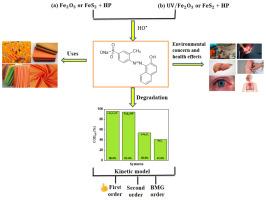利用基于亚铁和黄铁矿的芬顿和光芬顿工艺去除艳橙 R 的 COD
IF 6.7
2区 工程技术
Q1 ENGINEERING, CHEMICAL
引用次数: 0
摘要
合成染料,如在纺织工业中广泛使用的艳橙R (BO R),由于其毒性、持久性和对传统处理方法的抗性,对环境构成了重大挑战。因此,开发具有成本效益的技术至关重要。研究了纳米铁氧体(n-Fe2O3)和黄铁矿FeS2催化剂在Fenton工艺中对代表性有机污染物BO R的COD还原效果。催化剂按标准程序合成,并通过TEM、FT-IR、PXRD、EDX、XPS、VSM和拉曼光谱等多种技术进行表征。研究了添加和不添加过氧化氢(HP)、过硼酸钠(SPB)和过氧化叔丁基(thbhp)等氧化剂对COD的去除效果。在高压系统中,COD去除仅在90 min后开始,此后具有相同的COD去除效率(CODeff)(对铁氧体和黄铁矿分别为96.0和93.4%)。虽然SPB在两种催化剂体系中都能完全抑制CODeff,但TBHP只对黄铁矿起作用。然而,TBHP与n-Fe2O3的CODeff适中(75.5%)。暴露在紫外线下,CODeff的速率和强度增加。不同体系中,有或无紫外光照射的CODeff依次为:n-Fe2O3/HP >;FeS2 /惠普比;n-Fe2O3祝辞FeS2。此外,有和没有紫外线照射的COD消除分别遵循Behnajady-Modirshahla-Ghanbery和一级动力学模型。无机阴离子(Cl−、F−、Br−、NO3−和SO42−)对CODeff的抑制作用大于脱色作用。然而,阴离子对CODeff的影响是浓度依赖性的。本文章由计算机程序翻译,如有差异,请以英文原文为准。

COD removal of Brilliant Orange R using ferrite and pyrite based Fenton and photo-Fenton processes
Synthetic dyes, such as Brilliant Orange R (BO R) which are widely used in textile industries, represent a significant environmental challenge because of their toxicity, persistence, and resistance to conventional treatment methods. So, development of cost effective technologies is of paramount importance. This study investigates the use of nano-ferrite (n-) and pyrite catalysts in the Fenton process for reducing COD of BO R, a representative organic pollutant. The catalysts were synthesised by standard procedures and characterized by various techniques such as TEM, FT-IR, PXRD, EDX, XPS, VSM, and Raman spectroscopy. The COD removal was studied in all the systems with and without oxidants, including hydrogen peroxide (HP), sodium perborate (SPB), and tert-butyl hydroperoxide (TBHP). In HP systems, COD removal starts only after 90 min and, thereafter, possesses identical COD elimination efficiency () (96.0 and 93.4 %, respectively, for ferrite and pyrite). While SPB completely inhibits in both catalyst systems, TBHP does so only with pyrite. Nevertheless, TBHP displays a moderate (75.5 %) with n-. The rate and magnitude of increases in exposure to UV light. The in different systems, with or without irradiation of UV light, follow the order: n- > > n- > . Further, COD elimination with and without UV irradiation follows Behnajady-Modirshahla-Ghanbery, and first-order kinetic models, respectively. Inorganic anions (, , , and ) inhibit more in magnitude than decolorization. Nevertheless, the effect of anions on is concentration dependent.
求助全文
通过发布文献求助,成功后即可免费获取论文全文。
去求助
来源期刊

Journal of water process engineering
Biochemistry, Genetics and Molecular Biology-Biotechnology
CiteScore
10.70
自引率
8.60%
发文量
846
审稿时长
24 days
期刊介绍:
The Journal of Water Process Engineering aims to publish refereed, high-quality research papers with significant novelty and impact in all areas of the engineering of water and wastewater processing . Papers on advanced and novel treatment processes and technologies are particularly welcome. The Journal considers papers in areas such as nanotechnology and biotechnology applications in water, novel oxidation and separation processes, membrane processes (except those for desalination) , catalytic processes for the removal of water contaminants, sustainable processes, water reuse and recycling, water use and wastewater minimization, integrated/hybrid technology, process modeling of water treatment and novel treatment processes. Submissions on the subject of adsorbents, including standard measurements of adsorption kinetics and equilibrium will only be considered if there is a genuine case for novelty and contribution, for example highly novel, sustainable adsorbents and their use: papers on activated carbon-type materials derived from natural matter, or surfactant-modified clays and related minerals, would not fulfil this criterion. The Journal particularly welcomes contributions involving environmentally, economically and socially sustainable technology for water treatment, including those which are energy-efficient, with minimal or no chemical consumption, and capable of water recycling and reuse that minimizes the direct disposal of wastewater to the aquatic environment. Papers that describe novel ideas for solving issues related to water quality and availability are also welcome, as are those that show the transfer of techniques from other disciplines. The Journal will consider papers dealing with processes for various water matrices including drinking water (except desalination), domestic, urban and industrial wastewaters, in addition to their residues. It is expected that the journal will be of particular relevance to chemical and process engineers working in the field. The Journal welcomes Full Text papers, Short Communications, State-of-the-Art Reviews and Letters to Editors and Case Studies
 求助内容:
求助内容: 应助结果提醒方式:
应助结果提醒方式:


